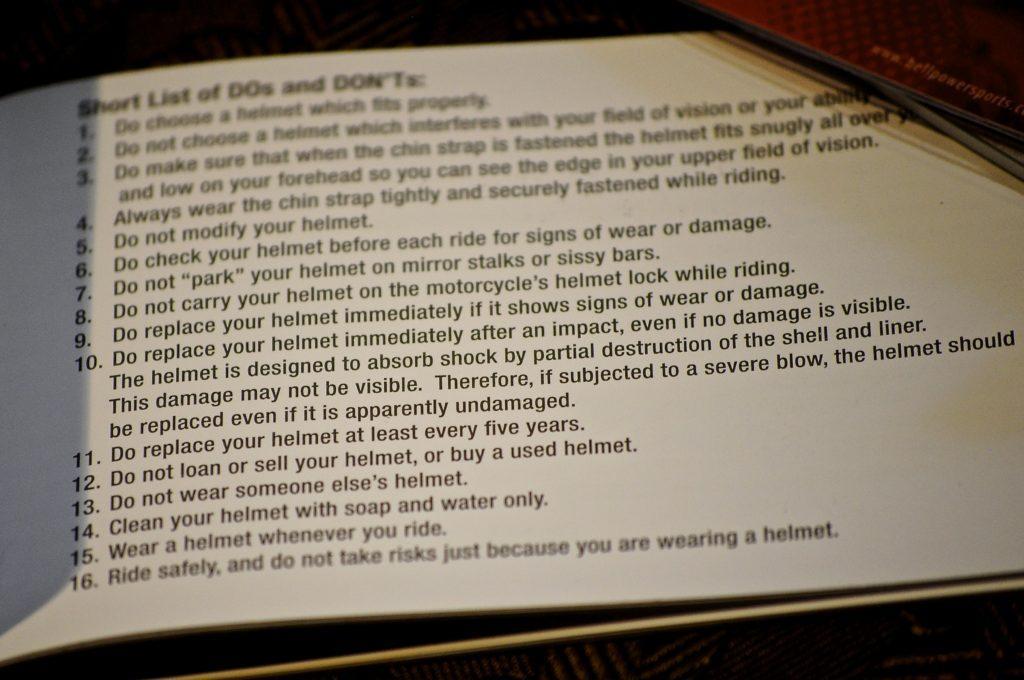
AT FIRST it was a pleasant surprise. Alan the head postie announced that, henceforth, all we Australia Post posties would get a new helmet every three years. Or, to be more precise, our helmets would be replaced as soon as they reached three years old. So if the ‘new’ helmet we got off the shelf 18 months ago was already 18 months old before we put it on our noggin, it would be replaced 18 months later.
But then it got me thinking. Three years? Really? Surely that’s overkill, I thought.
I realised that my trusty KBC ‘home helmet’ was not the world’s best helmet. It’s a bit noisy at highway speeds and is probably a smidgen too big for my pin postie head, but it does the job. I treat it well, and it’s never been dropped from a great height or whacked hard. So I’ve figured it was adequate.
 But when Al announced the new three-year-turnaround policy at Aussie Post, I crunched the numbers. Let’s see. I bought the KBC, um, how long ago? I guess it was not long after I sold the KTM. Yeah, that’s right. And that was, um, two-thousand-and … umm.. four. No, five. Five. Two thousand and five.
But when Al announced the new three-year-turnaround policy at Aussie Post, I crunched the numbers. Let’s see. I bought the KBC, um, how long ago? I guess it was not long after I sold the KTM. Yeah, that’s right. And that was, um, two-thousand-and … umm.. four. No, five. Five. Two thousand and five.
So it’s 11 years old. Cripes!
A closer look and I found the manufacture date. Well, I found the words ‘Manufacture Date’, but the date stamp was faded. Very faded. Under a better light and I could barely make out some digits. 2008? No, can’t be. Squint squint. Must be 2003. So that makes it 13 years old.
Now, I balk at the notion of throwing things away. Ever. That’s why I still have that 1979 PE 250 petrol tank in my shed. You never know …
And helmets aren’t cheap, are they? (OK, KBCs are, but you get my drift). So tossing a seemingly perfectly OK lid into the trash can and parting with several (or many) hundreds of dollars for another one just isn’t my idea of financial fun.
Besides, I really couldn’t give a holy hoot if my lid is out of fashion. And maybe there are better lids available now, but if it was good enough a decade or so ago then it’s good enough today.
Trying hard to convince myself that I could soldier on with the KBC, I hit the research trail to see what I could find.
Obviously the manufacturers are keen to sell you a new helmet as often as they can, so I consider their advice tainted …
Nonetheless, I had a look.
Here’s what Shoei says:
Helmet Replacement
Ultimately, the useful service life of a safety helmet is dependent on the intensity and frequency of its use. Helmet replacement is recommended even if only one of the under-mentioned points applies:
- The helmet was subjected to an impact.
- The comfort padding or the retention system has become loose due to heavy use or display signs of deterioration.
- The synthetic foam padding displays signs of heavy use and the helmet feels too loose. Test: with the retention system fastened, the helmet turns to the side when you gently shake your head.
- There are indentations in the EPS liner and/or white scratches can be seen on surfaces with black paint.
Even if none of these is applied, we, SHOEI, recommend replacement in 5 years after it’s first purchased at retail.
That’s a little better. Five years, not three, and five years after purchase, not after manufacture. But there’s no smoking gun here. Nothing to convince me that my old KBC is actually unsafe. OK, I take the point about the synthetic padding getting depressed over time (hey, don’t we all?) so the helmet is a bit loose. I’ll just tighten it a bit more …
Next stop, Snell, the international helmet standards organisation. They should know a thing or two, and are unlikely to be in the pocket of manufacturers.
Here’s what Snell says:
Why should you replace your helmet every five years?
The five-year replacement recommendation is based on a consensus by both helmet manufacturers and the Snell Foundation. Glues, resins and other materials used in helmet production can affect liner materials. Hair oils, body fluids and cosmetics, as well as normal “wear and tear” all contribute to helmet degradation. Petroleum based products present in cleaners, paints, fuels and other commonly encountered materials may also degrade materials used in many helmets possibly degrading performance. Additionally, experience indicates there will be a noticeable improvement in the protective characteristic of helmets over a five-year period due to advances in materials, designs, production methods and the standards. Thus, the recommendation for five-year helmet replacement is a judgment call stemming from a prudent safety philosophy.
I’m still not convinced. Degradation? What does that mean, precisely? And “possibly” degrading performance? Hhmm.
Next stop, I found a blog thread which sent a shiver down my spine. It was mostly about bicycle helmets, but posted on a motorcycling site and the subject matter was the hard white foam common to motorbike helmets as well.
Here’s the scarey bit:
Reddit forum:
[–]Cessnateur04 BMW R1150GS Adventure 21 points 2 years ago
(blah blah …) the foam hardens with age.
For many years, I worked in the bicycle industry. When I worked at shops, I would often have to destroy helmets that were turned into us through a crash-replacement program so they could not be used again. Some of these helmets were quite new, and had undergone a relatively mild crash.
When I took a small sledge hammer to these newer helmets, the foam was noticeably spongy, and it compressed a lot under impact.
Once in a while, I would use the same small sledge hammer to destroy an old helmet. In every case, an older helmet (5-10 years old) would break in a brittle fashion. The foam wouldn’t compress…it simply broke.
So with regard to both motorcycle and bicycle helmets, old foam is dangerous because it does not compress under impact…it simply transmits the force of the impact directly to your skull. You might as well wear a helmet made from solid hardwood.
Now, I have no idea who these people are, of course, and the guy might be mistaken or fibbing — but probably not.

Do you like my new Bell Star? I found it on sale at $399, reduced from $599. Nice snug fit. Lots of air vents. It’s a trusted brand. There’s no bluetooth connectivity, but it does have a special spot for some speakers. Groovy graphics. (OK, a bit boy racer for an old fart like me, but hey ..) Gosh, I can hardly wait to whack it against a kerb at 140kmh and see if it works. Only joking.
A good buy, I think. I’ll keep it for a few years. Maybe five. Or six. OK. Seven, tops.
One other thing. When I do eventually replace this one, I won’t buy top-of-the-line kit.
A wise bike mechanic once told me to stop buying expensive engine oil. “Buy something that costs half as much, and replace it twice as often,” he said. “Your engine will last twice as long. Really.” Smart guy.
So here’s my advice, stolen from that mechanic and applied to helmets.
Buy yourself a cheap helmet. Make sure it fits, make sure it’s fresh, and make sure it has appropriate certification (ECE22-05 or Standards Australia ANSI Z.90) but use a small enough budget so you will be willing to throw it in the bin in a few years’ time. If it’s going to be hard to throw away a $400 helmet after five or six years, and it will be, I just know how hard it will be to throw away a $1200 helmet.
Ride safe.
Shopping for a new helmet?
Here’s a few to choose from!







Hi Peter,
Great article. I too have a Bell. One suggestion is to buy the transition visor. Best visor ever if you ride a lot at dusk or dawn.
Scott